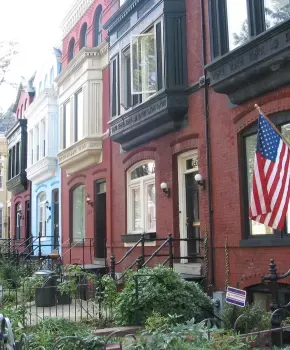Washington, D.C., the capital of the United States, is more than just a city; it’s a symbol of political compromise, deep-seated conflicts, and the ongoing struggle to define national identity. Founded in 1790, this city carries a complex history, from ambitious initial plans to periods of upheaval and revival. Let’s explore the journey of how Washington, D.C. was formed into what it is today.
A Historic Compromise and the Birth of the Capital
The location of Washington, D.C. was the result of a compromise between Alexander Hamilton and Thomas Jefferson. Hamilton, representing the Northern states, wanted the federal government to assume debts from the Revolutionary War. Meanwhile, Jefferson and the Southern states wanted the capital to be located closer to their agricultural and slave-holding interests.
President George Washington chose the site along the Potomac and Anacostia Rivers. In 1790, the city was officially established after Maryland and Virginia ceded land for the new “district.” Pierre Charles L’Enfant was tasked with designing the city. He envisioned a modern capital with wide avenues and grand spaces, inspired by other major world capitals. L’Enfant planned a grid system, with the Capitol building as its center.

Hardships and Reconstruction
During the War of 1812, British troops invaded and burned Washington, D.C., destroying many important buildings such as the White House, the Capitol, and the Library of Congress. Thomas Jefferson later sold his entire personal library to help rebuild the Library of Congress.
In 1847, a portion of the original city that belonged to Virginia was returned due to the dissatisfaction of voters in Alexandria, who felt neglected from development. The city only truly began to expand after the Civil War.
Civil War and Rapid Development
Washington, D.C. played a crucial role in the Civil War. Slaves in Washington were emancipated on April 16, 1862, before the Emancipation Proclamation. The city became a center for freed slaves and home to many African Americans, including abolitionist Frederick Douglass. A large army was established to protect the capital, and the federal government grew significantly.
After the Civil War, Washington experienced a significant period of expansion, incorporating Georgetown and surrounding rural areas. Florida Avenue, originally called Boundary Street, marked the original boundary of Washington City. The first residential areas formed around Capitol Hill, Downtown (Central Market), and the White House (Lafayette Square). The development of streetcar lines in the mid-19th century spurred the formation of new suburbs.

The McMillan Plan and Modernization
In 1901, the McMillan Plan was proposed to complete L’Enfant’s original designs. This plan included redesigning and expanding the National Mall, which became a symbol of Washington, D.C. The city continued to grow throughout the 20th century, although it experienced riots and civil unrest in the 1960s and 1970s. Many residents left the inner city for the suburbs. However, today, the inner city areas are undergoing urban revitalization, attracting many people back to live there.
Limited Self-Governance and Cultural Diversity
Despite being the nation’s capital, residents of Washington, D.C. lack full self-governance. Representation in Congress is limited. Washingtonians have only been allowed to vote in presidential elections since 1964 and elect a mayor since 1973.
Today, Washington, D.C. is a vibrant and culturally diverse city. It boasts numerous international cultures, African American heritage and culture, and is one of the most LGBTQ+-friendly cities in the U.S. Washington, D.C. recognized same-sex marriage in 2010, before the Supreme Court issued a similar ruling in 2015.
Washington, D.C. Today: A Harmonious Blend
After more than 200 years as the nation’s capital, Washington, D.C. has evolved into a complex and diverse city, serving as both a home for local residents and a center of international power and a captivating tourist destination. Visitors can explore the nation’s past at the National Mall and museums or experience the modernity and vibrancy of its neighborhoods.
Washington, D.C. is not just a capital but a living city where history, culture, and politics intersect. The formation and development of Washington, D.C. is a story full of ups and downs, reflecting the challenges and achievements of the United States.